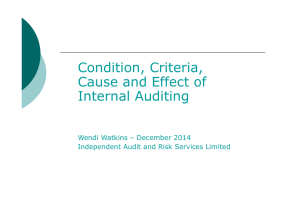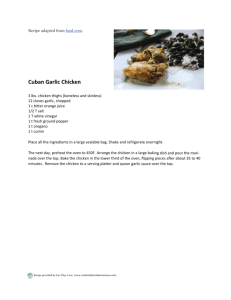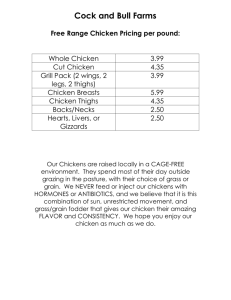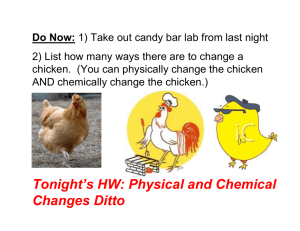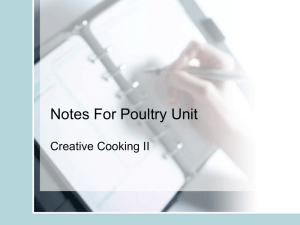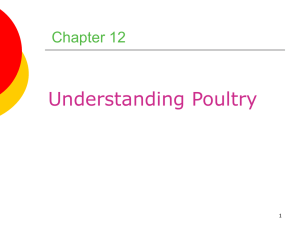Review Questions - Cooking Poultry
advertisement
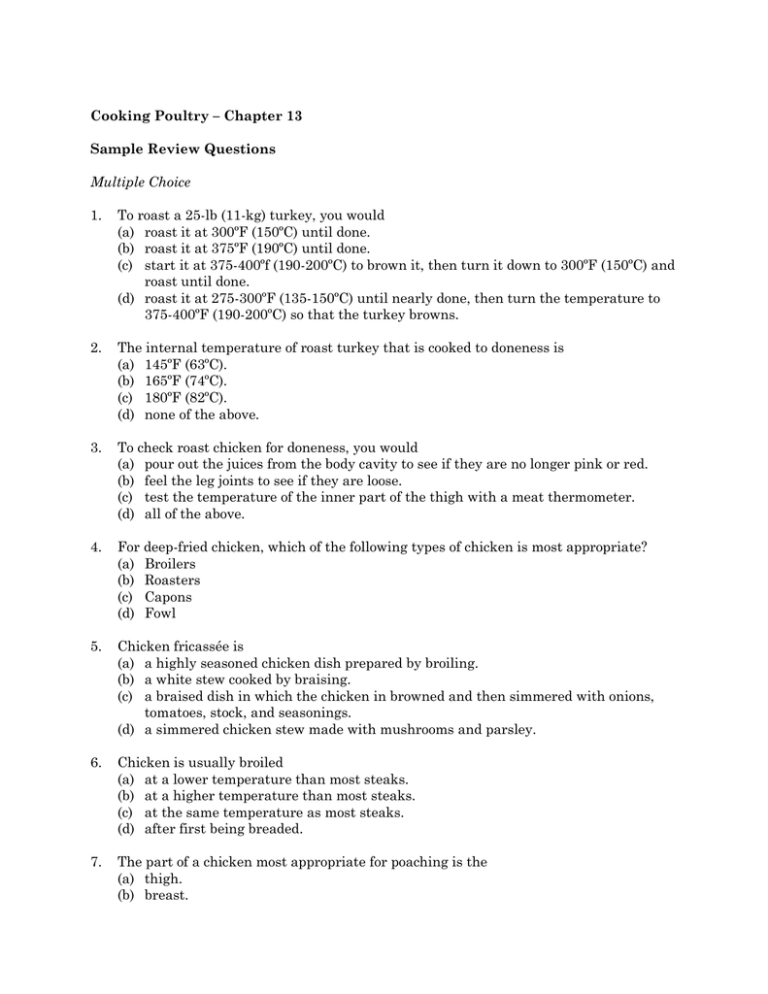
Cooking Poultry – Chapter 13 Sample Review Questions Multiple Choice 1. To roast a 25-lb (11-kg) turkey, you would (a) roast it at 300ºF (150ºC) until done. (b) roast it at 375ºF (190ºC) until done. (c) start it at 375-400ºf (190-200ºC) to brown it, then turn it down to 300ºF (150ºC) and roast until done. (d) roast it at 275-300ºF (135-150ºC) until nearly done, then turn the temperature to 375-400ºF (190-200ºC) so that the turkey browns. 2. The internal temperature of roast turkey that is cooked to doneness is (a) 145ºF (63ºC). (b) 165ºF (74ºC). (c) 180ºF (82ºC). (d) none of the above. 3. To check roast chicken for doneness, you would (a) pour out the juices from the body cavity to see if they are no longer pink or red. (b) feel the leg joints to see if they are loose. (c) test the temperature of the inner part of the thigh with a meat thermometer. (d) all of the above. 4. For deep-fried chicken, which of the following types of chicken is most appropriate? (a) Broilers (b) Roasters (c) Capons (d) Fowl 5. Chicken fricassée is (a) a highly seasoned chicken dish prepared by broiling. (b) a white stew cooked by braising. (c) a braised dish in which the chicken in browned and then simmered with onions, tomatoes, stock, and seasonings. (d) a simmered chicken stew made with mushrooms and parsley. 6. Chicken is usually broiled (a) at a lower temperature than most steaks. (b) at a higher temperature than most steaks. (c) at the same temperature as most steaks. (d) after first being breaded. 7. The part of a chicken most appropriate for poaching is the (a) thigh. (b) breast. (c) wing. (d) drumstick. 8. The first step in braising poultry is (a) blanching it in water. (b) simmering it in a seasoned liquid. (c) boiling it to remove impurities. (d) searing it in hot fat. 9. The breast meat of chicken and turkey is so similar to __________ that they are interchangeable in many recipes. (a) veal (b) beef (c) pork (d) all of the above 10. When seasoning and basting poultry, it is important to _____. (a) baste ducks and geese frequently (b) season the skin, even if it will not be eaten (c) baste large turkeys every 20 to 30 minutes if they are subjected to dry heat for several hours (d) carefully protect the skin from oil because oil will dry the skin and prevent it from browning 11. If you were cooking a __________, you would you not need to baste it while it cooked. (a) duck (b) goose (c) both a and b (d) neither a nor b 12. Which of the following combinations is correct? (a) searing — small chickens and chicken parts (b) high-temperature roasting — turkeys and capons (c) low-temperature roasting — squab and game birds (d) all of the above 13. __________ may be successfully "flash roasted" at high temperatures. (a) Duck breast (b) Cornish hens (c) Squab and game birds (d) all of the above 14. Because chicken and turkey are lean and tender meats, it is appropriate to cook them in fat by __________ them. (a) sautéing (b) pan-frying (c) deep-frying (d) all of the above 15. Which of the following statements is false about pan-frying poultry? (a) The side that is to face up on the plate should be browned first. (b) About ¼inch (½ cm) of fat in the pan is needed to pan-fry chicken. (c) Breading or flouring should be used so that the product will achieve even browning and crispness. (d) After browning on all sides on moderate heat, the temperature should be raised to high to insure doneness. 16. When deep-frying chicken, it is important to __________. (a) fry chicken at 325°F to 350°F (160°C to 175°C) (b) use pieces from larger chickens so they will not overcook (c) turn the products often so they will brown evenly on all sides (d) all of the above 17. The major difference between simmering and poaching is the _____. (a) type of liquid used (b) type of poultry being cooked (c) temperature of the liquid used (d) presence or absence of mirepoix 18. If you want the meat you are simmering to retain the most flavor, you should __________. (a) sear it first (b) start it in hot water (c) start it in cold water (d) season it before simmering it 19. All of the following statements about poaching are true except one. Which one is false? (a) Poaching is used to gently cook tender poultry. (b) Poaching helps poultry retain its moisture and develop a light, subtle flavor. (c) Cooking time for poaching is usually very long due to the low temperature used. (d) The liquid used in poaching can be used to make a sauce to serve with the cooked product. 20. Braising can add __________ to poultry products. (a) flavor (b) moisture (c) tenderness (d) all of the above 21. Coq au vin is an example of a __________ chicken dish. (a) braised (b) sautéed (c) poached (d) simmered 22. Which of the following statements about chicken poêlé is correct (a) The chicken is basted generously with butter. (b) The chicken is cooked with a matignon. (c) The chicken is baked in a covered casserole. (d) all of the above 23. In a fricassée, chicken is __________ (a) seared, but not browned (b) barded with bacon to increase its moistness (c) poached in a broth fortified with white wine (d) first seared and then cooked in a brown roux with vegetables 24. Which of the following statements about stuffing is not true? (a) The flavor of dressing cooked outside a bird is superior to stuffing that has been cooked inside a bird. (b) Additional time is needed to cook stuffing thoroughly, and this often results in an overcooked bird." (c) It is less practical to fill a bird with stuffing and then have to remove the stuffing after the bird is cooked. (d) Stuffing a chicken or turkey is unsafe because the inside of a bird is an ideal breeding ground for the types of bacteria that can produce food poisoning. 25. Although it is not advisable to stuff most poultry, __________ are often stuffed. (a) very large turkeys (b) Cornish hens and quail (c) ducks, geese, and other waterfowl (d) capons and other neutered poultry 26. Which of the following can be added to dressing to add flavor, character, and/or bulk? (a) oysters (b) giblets or sausage (c) nuts, fruits, or chestnuts (d) all of the above 27. Which of the following is not a recommended guideline for making dressings? (a) Bake dressing in shallow pans. (b) Do not pack dressing or stuffing tightly into baking pans or poultry." (c) Be sure to cool all the ingredients thoroughly before combining them in order to avoid the growth of dangerous bacteria. (d) It is not necessary to cook the ingredients in stuffing before you combine them because they will cook during the baking process. 28. Which of the following statements is incorrect? (a) Roasting and baking are the same process. (b) Poultry items are almost always cooked well done. (c) Simmering temperature is lower than poaching temperature. (d) The presentation side of a piece of poultry is usually the skin side. 29. The true meaning of the term “teriyaki” is _________________________. (a) marinated in soy sauce (b) glaze-grilled (c) deep-fried in a light batter (d) simmered in a soy sauce mixture 30. Unlike salsas, Mexican moles always _____________________. (a) are cooked (b) contain chocolate (c) contain tomatoes (d) all of the above 31. Which part of the duck or goose is most often used to make confit? (a) leg (b) breast (c) livers (d) the whole, uncut bird 32. When poultry is cooked “en cocotte,” it is cooked ___________________. (a) in a paper envelope (b) in enough fat to cover it completely (c) on a spit (d) in a casserole True/False 33. If poultry is basted during roasting, it should be basted with fat. 34. Ducklings should be basted frequently during roasting in order to reduce their high fat content. 35. After roasting, turkey should be allowed to stand for at least 15 minutes before carving. 36. Rock Cornish Game Hens should not be broiled because they become overcooked very quickly at high temperatures. 37. Pan-fried chicken pieces should be browned on the skin side first. 38. A major difference between deep-frying and pan-frying chicken is that deep-fried chicken is usually breaded, while pan-fried chicken is never breaded or dredged in flour. 39. When celery is added to bread dressing, it should be cooked before being combined with the other ingredients. 40. In order to prevent the growth of bacteria that cause food poisoning, pans of baked dressing should be reheated by removing them from the refrigerator and placing them directly in the steam table. 41. The correct order of steps in making gravy for poultry are to brown the mirepoix, deglaze the roasting pan with stock, strain the liquid, and thicken with roux. 42. Broiled chicken may be seasoned on the skin side before cooking. 43. During braising of poultry, the pot should be kept uncovered. Answers to Test Questions 1. a 2. c 3. d 4. a 5. b 6. a 7. b 8. d 9. a 10. c 11. c 12. a 13. d 14. d 15. d 16. a 17. c 18. b 19. c 20. d 21. a 22. d 23. a 24. a 25. b 26. d 27. d 28. c 29. b 30. a 31. a 32. d 33. T 34. F 35. T 36. F 37. T 38. F 39. T 40. F 41. F 42. T 43. F Answers to Questions for Discussion 1. 2. 3. 4. 5. 6. Low-temperature roasting: continuous roasting at low temperature, 300-325ºF or 150160ºC, even lower for large turkeys. Used for large items such as turkeys, capons, and roasting chickens. Searing: start at 450ºF or 230ºC for 15 minutes to brown the item, then continue roasting at 250º-325ºF or 120-160ºC. Used for chickens under 4-5 lb (about 2 kg), which would be browned very little at continuous low temperature. High temperature roasting: continuous roasting at high temperatures, around 400ºF or 200ºC. Used for very small items, particularly for game birds to be served rare. (386) True. Chicken, especially dark meat, takes longer to cook and would be burned on the outside if broiled at the same temperature as steaks. Boneless chicken breasts, which cook quickly, are an exception. (399) The side that is to be facing up when the item is served. This side should be browned first when pan-frying, because this results in the best appearance. (406) Large pieces take a long time to cook, so that it is difficult to have them thoroughly cooked without browning them excessively. One solution is to deep-fry only small chickens. Another is to brown the chickens in deep fat, then finish them in the oven on sheet pans. (407) Simmering generally uses a higher temperature and more liquid than poaching does. Simmering is used primarily to cook larger items, especially those that need long, moist cooking to make them tender. Broth is a by-product. Poaching is used to quickly cook small, tender pieces like boneless chicken breasts in a flavorful liquid. (419) Safety (avoiding bacterial growth in the stuffing). Quality (stuffing the bird extends cooking time). Practicality (stuffing the bird is impractical, time-consuming, and messy). (438)

